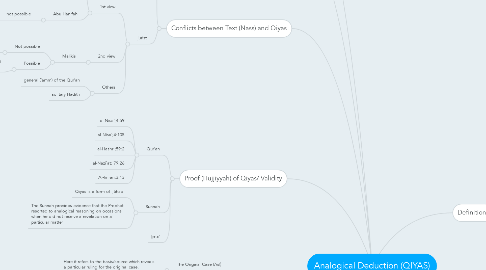
1. Conditions
1.1. The Original Case (Asl)
1.1.1. Here it refers to the basis/source which reveals a particular ruling for the original case.
1.2. New case (far`)
1.2.1. New case (far`)
1.2.1.1. The new case must not be covered by the text or ijma`.
1.2.1.2. The effective cause of analogy must be applicable to the new case in the same way as to the original case
1.2.1.3. The application of qiyas to a new case must not result in altering the law of the text
1.3. The Ruling (Hukm)
1.3.1. Qiyas can only be attempted when there is a ruling (hukm) available in the sources (text and ijma’).
1.3.2. In the event where no ruling can be found in any of the 3 sources regarding a case, no ruling could be said to exist
1.3.3. The Effective Cause ('Illah)
2. Identification of the effective cause
2.1. clearly stated/suggested by indications in the text (nass).
2.2. determined by consensus (ijma’).
2.3. a. Expressly identified in the text
2.3.1. al-Nisa; 4:43)
2.4. b. Established by consensus
2.4.1. The priority of germane over consanguine brothers in inheritance
2.4.2. Father's right of guardianship over the property of his minor.
3. Types
3.1. Analogy of the Superior (qiyas al-awla
3.1.1. al-Isra‘’17:23
3.2. 'Analogy of Equals' (qiyas al-musawi).
3.2.1. al-Nisa', 4:2
3.3. Analogy of the Inferior' (qiyas al-adna).
3.3.1. The rules of riba, prohibit the exchange of wheat and of other specified commodities unless the two amounts are equal and delivery is immediate
3.4. Hanafi Division
3.4.1. Obvious analogy (qiyas jali
3.4.2. Hidden analogy (qiyas khafi
4. Proof (Hujjiyyah) of Qiyas/ Validity
4.1. Qur’an
4.1.1. al-Nisa‘;4:59
4.1.2. al-Nisa‘;4:105
4.1.3. al-Hashr ;59:2
4.1.4. al-Nazi`at; 79:26
4.1.5. Al-Imran;3:13
4.2. Sunnah
4.2.1. Qiyas is a form of ijtihad
4.2.2. The Sunnah provides evidence that the Prophet resorted to analogical reasoning on occasions when he did not receive a revelation on a particular matter
4.3. Ijma’
5. Conflicts between Text (Nass) and Qiyas
5.1. Issue
5.1.1. Possibility of qiyas coming into conflict with the text (nusus).
5.2. jurist
5.2.1. 1st view
5.2.1.1. Imam Shafi'i, Ahmad b. Hanbal
5.2.1.2. Abu Hanifah
5.2.1.2.1. not possible
5.2.2. 2nd view
5.2.2.1. Malikis
5.2.2.1.1. Not possible
5.2.2.1.2. Possible
5.2.3. Others
5.2.3.1. general (‘amm) of the Qur'an
5.2.3.2. solitary Hadith
6. Conflict between qiyas and a solitary Hadith
6.1. Imam Shafi`i, Ibn Hanbal & Abu Hanifah
6.1.1. Solitary Hadith take priority over qiyas.
6.2. Some Hanafis & Ibn Arabi
6.2.1. Solitary Hadith takes priority over qiyas when a solitary Hadith is supported by another principle of Shariah.
6.3. The Malikis & some Hanbalis scholars
6.3.1. Qiyas will take priority over a solitary Hadith - if qiyas can be substantiated by another principle or asl of the Shari'ah
7. Divisions of Qiyas by Abu's Husayn al-Basri
7.1. Qiyas which is founded in a decisive nass
7.2. Qiyas which is founded in speculative evidence
7.3. Qiyas in which both the asl and the 'illah are founded in speculative nusus
7.4. Qiyas in which the `illah is determined through istinbat but whose original case is a clear text of the Qur'an or Mutawatir Hadith
8. Definitions
8.1. Literal
8.1.1. Measuring/ ascertaining the length, weight/quality of something
8.1.2. Comparison with a view to suggesting equality/similarity between two things
8.2. Technical
8.2.1. The extension of the ruling (hukm) from an original case (asl) to a new case(far')on which the law is silent, due to the similarity of effective cause ('illah) for both

